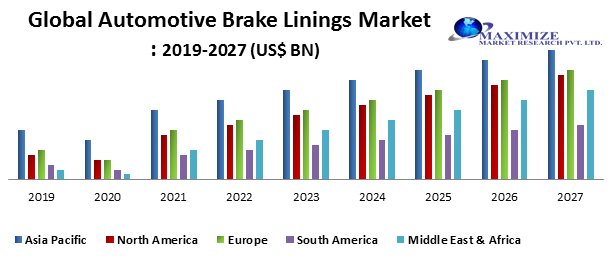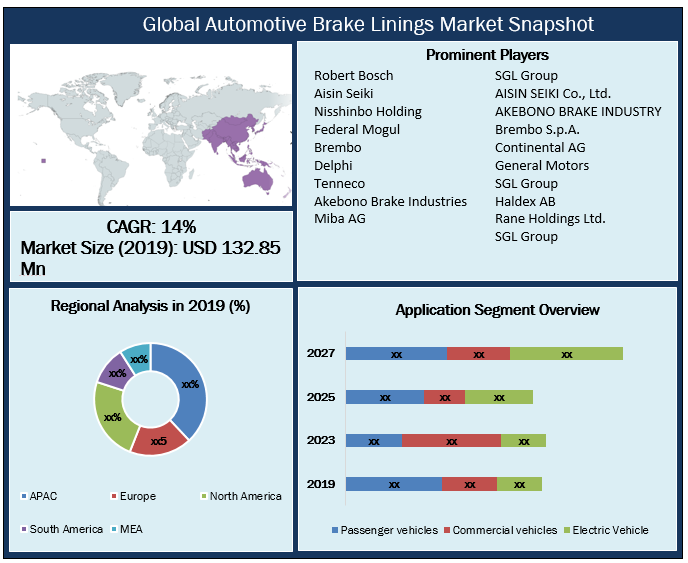Global Automotive Brake Linings Market size was valued at US$ 132.85 Mn. in 2019 and the total revenue is expected to grow about 14% from 2020 to 2027, reaching nearly US$ 278.85 Mn. 
Global Automotive Brake Linings Market Definition
Brake Linings permits collective access of data which is circulated and helps in maintaining the trust and privacy of the customers. Brake Linings technology influences every industry. Automotive Brake Linings has numerous advantages, such as an overall drop in the ownership cost, on-time transactions, and low data manipulation and leaks. Brake Linings simplify business processes and create operation clear and flexible.  It is well-known that the automobile brake system is the most important system in vehicles. If the brake fails, there may be a crash, people may be injured and even die. In addition, the automobile brake system is an essential element to measure the performance of an automobile. The performance of the brake system directly affects the other properties of the vehicles. According to different components of brakes, there are disc brakes and drum brakes on the market. According to different materials of brake pads, there are four most common types: non-asbestos organic (NAO), ceramics, semi-metallic, and low metallic brake pads. This chapter will introduce the market of different brakes and brake linings. Brake linings generally comprise five main components: binders, fibers, fillers, frictional additives or lubricants, and abrasives. Binders hold the components of the brake pad together and ensure the structural integrity of the lining under mechanical and thermal stress. They account for 20–40% of the lining material. Reinforcing fibers provide mechanical strength and structure to the lining. They usually account for 6–35 % (by mass) of the lining material. Fillers are used in order to improve thermal and noise pad properties and also to reduce the manufacturing cost and account between 15 and 70% (by mass) of the lining material. Lubricants influence the wear characteristics of the lining. They usually make up 5-29% (by mass) of the brake lining. The base year for the study has been considered 2019, the historic year 2016 and 2019 and the forecast period considered is from 2020 to 2027. The automotive brake linings market is analyzed on the basis of value (USD Million). High demand for automotive brake linings are from commercial vehicles such as construction and agricultural equipment.
It is well-known that the automobile brake system is the most important system in vehicles. If the brake fails, there may be a crash, people may be injured and even die. In addition, the automobile brake system is an essential element to measure the performance of an automobile. The performance of the brake system directly affects the other properties of the vehicles. According to different components of brakes, there are disc brakes and drum brakes on the market. According to different materials of brake pads, there are four most common types: non-asbestos organic (NAO), ceramics, semi-metallic, and low metallic brake pads. This chapter will introduce the market of different brakes and brake linings. Brake linings generally comprise five main components: binders, fibers, fillers, frictional additives or lubricants, and abrasives. Binders hold the components of the brake pad together and ensure the structural integrity of the lining under mechanical and thermal stress. They account for 20–40% of the lining material. Reinforcing fibers provide mechanical strength and structure to the lining. They usually account for 6–35 % (by mass) of the lining material. Fillers are used in order to improve thermal and noise pad properties and also to reduce the manufacturing cost and account between 15 and 70% (by mass) of the lining material. Lubricants influence the wear characteristics of the lining. They usually make up 5-29% (by mass) of the brake lining. The base year for the study has been considered 2019, the historic year 2016 and 2019 and the forecast period considered is from 2020 to 2027. The automotive brake linings market is analyzed on the basis of value (USD Million). High demand for automotive brake linings are from commercial vehicles such as construction and agricultural equipment.
Global Automotive Brake Linings Market Regional Analysis
In Europe, although the decline to 21.3 million units is rather small compared to the 2017 level (22.2 million units) – i.e. more than 22% of the global production, the various countries show contrasting results. Germany, the United Kingdom, and Italy declined by -9% to -7%. Spain declined slightly by 1%. France on the other hand remains a rather dynamic production zone with a growth of 2%, just like Eastern Europe where production grew by 5% to 4.2 million units. Russia experienced a more remarkable growth than in 2017, by +14%. In America, the 2018 production of 20.8 million units represents a 21% share of the global production, comparable to the European share. In the United States and Mexico, production remains high thanks namely to light-duty trucks (+4%). Canada however declined for the second year in a row. In South America, Brazil confirmed its recovery with a 5% growth, while the crisis in Argentina negatively impacted production (-1%). Asia- Pacific is dominating the market due to emerging new economy and disposable income. Moreover, the evolution of new OEMs driving the automotive brake lining market. Also, the high demand for passenger and commercial vehicles in developing countries is also driving market growth in this region. North America is the fastest growing market due to low volume and high growth. The increasing investments in the automobile sector are also motivating to the growth of the market. MMR forecasts that the three-wheeled Automotive Brake Linings segment is projected to reach USD XX Mn in 2027 from USD XX Mn in 2019, representing a compound annual growth rate (CAGR) of 9.5% from 2020 to 2027. The report also helps in understanding Automotive Brake Linings Market dynamics, structure by analyzing the market segments and projects the market size. Clear representation of competitive analysis of key players by Application, price, financial position, Product portfolio, growth strategies, and regional presence in the make the report investor’s guide.
Global Automotive Brake Linings Market Scope
Global Automotive Brake Linings Market, by Application
• Passenger vehicles • Commercial vehicles • Electric Vehicle
Global Automotive Brake Linings Market, by Material Type
• Asbestos Based Automotive Brake Linings • Non- Asbestos Based Automotive Brake Linings
Global Automotive Brake Linings Market, by Sales Channel
• Original Equipment Manufacturer (OEM) • Aftermarket
Global Automotive Brake Linings Market, by Region
• Asia Pacific • North America • Europe • South America • Middle East & Africa
Global Automotive Brake Linings Market Key players
• Robert Bosch (Germany) • Aisin Seiki (Japan) • Nisshinbo Holding (Japan) • Federal Mogul (US) • Brembo (Italy) • Delphi (Now Aptiv) (UK) • Tenneco (US) • Akebono Brake Industries (Japan) • Miba AG (Germany) • SGL Group (Germany) • AISIN SEIKI Co., Ltd. • AKEBONO BRAKE INDUSTRY CO., LTD. • Brembo S.p.A. • Continental AG • General Motors • SGL Group • Haldex AB • Rane Holdings Ltd.